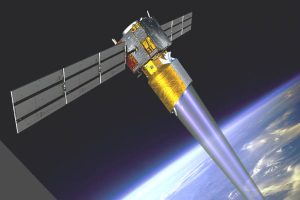At the Small Satellite Conference in Utah, Imec announced a hyperspectral sensor with an on-chip line-based filter covering 450 – 900nm in 96 bands. It had equidistantly divided spectral bands and, compared with its previous generation, double the TDI (time-delayed-integration) capacity – to 10 line per band. Underneath the filter is a ‘2/3inch’ 2,048pixel image sensor from AMS – the ...
Tag Archives: image sensor
1,280×1,024 10µm-pitch read-out IC for infra-red imagers
Senseeker has introduced a 1,280 x 1,024 version of its 10µm digital read-out IC (‘droic’) for short-wave infra-red imaging arrays, including quantum dot-based detector types. RD0131 as it will be known has a capacitive transimpedance amplifier (CTIA) front-end. There are three selectable gains, with well capacity of: 22k electrons (high-gain), 160ke- (medium) or 1.1Me- (low). In high gain, room temperature ...
X-ray image sensor with 1,272 x 1,104 pixels
Hamamatsu Photonics has created an x-ray image sensor for real-time non-destructive testing and digital radiography. C16401SK-51 has 1,272 x 1,104 pixels, a photo-sensitive area of 140 x 122.8mm, and uses cmos sensing with a GOS (gadolinium oxysulfide) scintillator. “This combination ensures optimal performance and reliability, even when used with x-ray tube voltages of up to 160kV, making it suitable for ...
ECTC: Triple wafer stacking for image sensors with embedded AI
French research lab CEA-Leti has reported stacking three 300mm wafers for improved CMOS image sensors, using hybrid wafer bonding and high-density through-silicon vias. The announcement was made in three papers at ECTC, the 2024 IEEE Electronic Components and Technology Conference in Colorado. 6μm hybrid bonding pad pitch, and TSVs are 1 x 10μm It is working towards a new generation ...
Adhesive bonds glass to die for image sensors
Delo has created a sealant adhesive for bonding glass filters directly on to cmos image sensor die. “EG6290 can be dispensed in narrow high bond-lines, can compensate for temperature-dependent pressure changes, and meets routine automotive standards,” according to the company, which clarified that it “fulfills the requirements of the AEC-Q100 Grade 2 automotive industry standard”. Young’s modulus is 2,350MPa and ...
Alt-Alt Top 10 units of measurement in the Gadget Master scale
I've found a further breakaway Alternate Top 10 units of measurement in the Gadget Master scale. These are the colloquial, sub-edital, and rather eccentric ways to measure cutting-edge items of current technology.
Industrial colour and mono cameras with Sony IMX662 sensor
Imaging Development Systems (IDS) is offering Sony’s IMX662 1/2.45 inch 2.16 Mpixel sensor in both colour and monochrome cameras. U3-38C0XCP comes in a completely closed 29 x 29 x 17mm zinc die-cast housing with an integral C-mount lens holder. “The sensors belonging to Sony’s Starvis 2 series are designed for maximum light sensitivity,” according to IDS. “We offer this rolling ...
ST makes giant image sensor for Las Vegas attraction
STMicroelectronics has made a custom 316Mpixel 18K image sensor for a company with a super-high resolution cinema in Las Vegas. The die measures 99 x 83mm (82.4cm2) – four fit onto a 300mm wafer (right). It can capture images at 120frame/s and transfer data at 60Gbyte/s. “Building a custom sensor of this size, resolution and speed, with low noise, high ...
5K industrial camera is 29 x 29 x 17mm
IDS has adopted Onsemi’s 20Mpixel AR2020 image sensor for an industrial camera called uEye+ XCP. It has 5,136 x 3,856 pixels, a USB3 interface and a closed housing measuring 29 x 29 x 17mm that includes a mechanical interface for C-mount lenses. “With the rolling shutter sensor AR2020 [is] the technical successor of the Onsemi AR1820,” said IDS. “With 20Mpixel, ...
A fiery end to Aeolus, and its Chelmsford-made image sensor
ESA has begun the controlled destruction of its Aeolus global wind-measuring satellite. Launched in 2018, the 1.3 tonne satellite has already worked 18 months longer than its planned three year mission, but is now running out of orbit-maintaining fuel. Matter and radiation released by recent solar flares and coronal mass ejections have temporarily increased drag in space, and ESA is ...
 Electronics Weekly Electronics Design & Components Tech News
Electronics Weekly Electronics Design & Components Tech News









